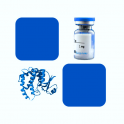
- Remove this product from my favorite's list.
- Add this product to my list of favorites.
Products
Newsletter
 |  |  |  |  |  |

Background
Fibrinogen-like protein 1(FGL1) is also known as HP-041, Hepassocin, HFREP-1, LFIRE-1. The protective effect of fibrinogen-like protein 1 (FGL1) in liver injury has previously been reported. However, studies have shown that FGL1 may be a predictor of GC patients and a target for GC therapy. Immunocytochemical studies revealed that fgl1 selectively binds to defective spermatozoa in the cauda epididymidis. Northern blot analysis and in situ hybridization demonstrated the high expression of fgl1 in the principal cells of the proximal cauda epididymidis. Immunofluorescence analysis using mouse fibrotic lung tissues suggested that fibrotic regions showed increased expressions of Gtse1 and Fgl1, Gtse1 and Fgl1 are suggested to be novel targets for radiation-induced lung fibrosis.
Source
Recombinant Human FGL1, His Tag (FG1-H52Hy) is expressed from human 293 cells (HEK293). It contains AA Leu 23 - Ile 312 (Accession # Q08830-1).
Molecular Characterization
This protein carries a polyhistidine tag at the N-terminus.
The protein has a calculated MW of 36.0 kDa. The protein migrates as 33-35 kDa under reducing (R) condition (SDS-PAGE) due to glycosylation.
Endotoxin
Less than 1.0 EU per μg by the LAL method.
Purity
>90% as determined by SDS-PAGE.
Formulation
Lyophilized from 0.22 μm filtered solution in PBS with Arginine, pH7.4 with trehalose as protectant.
Reconstitution
Please see Certificate of Analysis for specific instructions.
For best performance, we strongly recommend you to follow the reconstitution protocol provided in the CoA.
Storage
For long term storage, the product should be stored at lyophilized state at -20°C or lower.
Please avoid repeated freeze-thaw cycles.
This product is stable after storage at:
-20°C to -70°C for 12 months in lyophilized state;
-70°C for 3 months under sterile conditions after reconstitution.
Bioactivity
Please refer to product data sheet.
1) "Systematic review and bioinformatics analysis of plasma and serum extracellular vesicles proteome in type 2 diabetes"
Arredondo-Damián, Martínez-Soto, Molina-Pelayo et al
Heliyon (2024) 10 (3), e25537
(2) "Immunological characterization of a long-lasting response in a patient with metastatic triple-negative breast cancer treated with PD-1 and LAG-3 blockade"
Rivoltini, Camisaschi, Fucà et al
Sci Rep (2024) 14 (1), 3379
(3) "The hepatokine FGL1 regulates hepcidin and iron metabolism during anemia in mice by antagonizing BMP signaling"
Sardo, Perrier, Cormier et al
Blood (2023)
Showing 1-3 of 136 papers.
Follow us